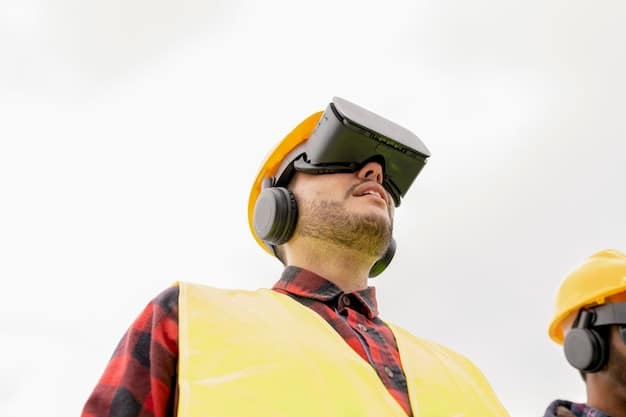XR’s Impact: Reshaping US Job Training Programs by 2025

Emerging as a transformative force, Extended Reality (XR) is poised to fundamentally redefine US job training programs by 2025 by offering immersive, cost-effective, and highly engaging learning environments that bridge the gap between theoretical knowledge and practical application across diverse industries.
As we navigate the rapidly evolving landscape of career development, a pervasive question emerges: How is Extended Reality (XR) Reshaping US Job Training Programs in 2025? This profound shift goes beyond mere technological adoption; it represents a paradigm change in how skills are acquired, refined, and applied across various industries.
Understanding the Core of XR Technology in Training
The advent of Extended Reality, encompassing Virtual Reality (VR), Augmented Reality (AR), and Mixed Reality (MR), represents a significant leap from traditional training methodologies. This technology is creating highly interactive and immersive environments that mimic real-world scenarios, allowing trainees to practice complex tasks without the associated risks or costs of traditional, hands-on training. This adaptability is proving invaluable across various sectors, from healthcare to heavy industry, fundamentally altering the educational process.
The Spectrum of XR: VR, AR, and MR
Each facet of XR offers unique advantages for job training. Virtual Reality, for instance, fully immerses users in simulated environments, ideal for practicing high-risk procedures or exploring inaccessible locations. Augmented Reality overlays digital information onto the real world, enhancing tasks like equipment maintenance with real-time data. Mixed Reality blends the two, allowing digital objects to interact with the physical environment, fostering collaborative training scenarios.
- Virtual Reality (VR): Offers complete immersion, excellent for procedural training, emergency simulations, and skill repetition in a controlled environment.
- Augmented Reality (AR): Enhances real-world tasks with digital overlays, perfect for on-the-job guidance, collaborative design reviews, and maintenance tasks.
- Mixed Reality (MR): Combines virtual and real elements, enabling interactive and collaborative training where trainees can manipulate virtual objects within their physical space.
These distinct yet interconnected technologies are being strategically deployed to address specific training needs, providing scalable and efficient solutions that were once deemed futuristic. The capacity to simulate diverse conditions and scenarios ensures that trainees are not only knowledgeable but also proficient in practical application, reducing errors and increasing confidence before engaging with real-world complexities.
Driving Factors Behind XR Adoption in US Workforce Development
The rapid integration of XR into US job training programs by 2025 is not arbitrary; it is driven by a confluence of economic, technological, and societal pressures. Organizations are increasingly seeking training solutions that are not only effective but also efficient and adaptable to the dynamic demands of modern industries. XR delivers on these fronts by overcoming many limitations inherent in conventional training approaches.
Economic Efficiency and Scalability
One of the primary catalysts for XR adoption is its proven ability to reduce training costs while simultaneously enhancing scalability. Traditional training, especially in fields requiring specialized equipment or hazardous environments, can be prohibitively expensive due to travel, equipment wear and tear, and instructor fees. XR mitigates these expenses significantly. Through virtual environments, a single training module can be replicated and deployed to thousands of trainees concurrently, regardless of their geographical location.
- Reduced Costs: Eliminates expenses associated with physical infrastructure, travel, and specialized equipment.
- Global Scalability: Allows consistent, high-quality training to be delivered to a large, geographically dispersed workforce.
- Faster Onboarding: Accelerates the learning curve for new hires, making them productive more quickly.
This economic leverage is particularly appealing to large corporations and government agencies looking to optimize their training budgets while maintaining high standards of skill development.
Enhanced Learning Outcomes and Engagement
Beyond cost-efficiency, XR training platforms are demonstrating superior learning outcomes compared to traditional methods. The immersive and interactive nature of XR keeps trainees highly engaged, fostering deeper understanding and better retention of information. Experiential learning, where trainees actively participate in simulated tasks, leads to a more profound grasp of concepts than passive methods like lectures or reading.

The ability to fail safely in a virtual environment encourages experimentation and builds confidence. Trainees can repeat modules as many times as necessary without fear of real-world consequences, thereby refining their skills at their own pace. This personalized learning path caters to diverse learning styles and paces, ensuring that each individual achieves mastery. Immediate feedback loops within XR simulations also help correct errors in real-time, solidifying correct procedures.
Sector-Specific Applications: Where XR is Making a Mark
The versatile nature of Extended Reality technology means its impact isn’t confined to a single industry. By 2025, XR applications are diversifying, proving their efficacy across a wide array of sectors that require specialized skills and complex training scenarios. Each industry leverages XR’s unique capabilities to address its particular challenges and enhance operational readiness.
Healthcare and Medical Training
In the healthcare sector, XR is revolutionizing how medical professionals are trained. Surgeons can practice intricate procedures on virtual patients, emergency responders can simulate disaster scenarios, and medical students can explore human anatomy in three dimensions. This significantly reduces the risks associated with learning on real patients and provides unprecedented access to rare medical cases for practice. The ability to simulate various physiological responses and complications in a safe environment prepares practitioners for unpredictable real-world situations.
Manufacturing and Industrial Skills
For manufacturing and heavy industries, XR offers solutions for training workers on complex machinery and assembly lines. Using VR, new employees can learn to operate industrial equipment safely and efficiently, reducing the risk of accidents and equipment damage. AR overlays provide step-by-step instructions for maintenance and repair, enhancing efficiency and minimizing downtime. This also facilitates the transfer of knowledge from experienced workers to new generations, preserving invaluable expertise.
- Equipment Operation: Safe practice with virtual machinery, reducing physical risk and wear.
- Assembly Procedures: Step-by-step guidance via AR overlays, ensuring precision and minimizing errors.
- Safety Protocols: Immersive simulations of hazardous environments for practicing emergency responses.
These applications accelerate skill acquisition, improve safety compliance, and boost overall productivity in industrial settings.
Retail and Customer Service
Even customer-facing roles are benefiting from XR. Retail employees can use VR to practice customer interactions, handle difficult scenarios, and learn product placements in a simulated store environment. This allows them to develop soft skills and product knowledge without impacting real customer experiences. Training in a virtual retail space also enables companies to test new store layouts or product displays before implementing them physically, optimizing the customer journey.
Challenges and Considerations for Widespread XR Adoption
While the advantages of Extended Reality in job training are evident, its widespread implementation is not without hurdles. Organizations looking to integrate XR must navigate technological, financial, and cultural challenges to ensure successful adoption and optimal return on investment. Addressing these issues proactively will be crucial for the sustained growth of XR in workforce development.
Cost of Initial Investment and Infrastructure
The upfront cost associated with XR hardware (headsets, haptic devices) and software development can be substantial. For smaller businesses or those with limited budgets, this initial outlay can be a significant barrier. Furthermore, robust IT infrastructure is necessary to support the high data transfer rates and processing power required for immersive XR experiences. Ensuring compatibility with existing systems and maintaining these advanced infrastructures adds complexity.
Content Creation and Customization
Developing high-quality, relevant XR training content is a specialized and time-consuming process. It requires expertise in 3D modeling, game development, instructional design, and a deep understanding of the specific job tasks being simulated. Generic content often falls short, meaning significant customization is usually necessary to meet the unique needs of an organization. This demand for bespoke content can escalate development costs and timelines.
- Specialized Expertise: Requires designers, developers, and instructional technologists.
- Time-Consuming Process: Iterative development and testing cycles are common.
- Scalability of Content: Ensuring content remains relevant and adaptable as job roles evolve.
The investment in custom content development is ongoing, as training modules will need regular updates to reflect changes in technology, procedures, or industry standards.
User Acceptance and Ergonomics
Despite growing familiarity with XR, some trainees may experience discomfort, motion sickness, or simply a reluctance to adopt new technologies. Ensuring a comfortable and intuitive user experience is paramount. Headset design, weight, field of view, and resolution all play a role in user acceptance. Addressing potential ergonomic issues and overcoming initial resistance through clear communication and well-designed user interfaces will be vital for broader acceptance.
The Role of Data Analytics and AI in XR Training
The true power of Extended Reality in job training extends beyond mere simulation; it lies in its capacity to generate vast amounts of performance data. By 2025, the integration of data analytics and Artificial Intelligence (AI) with XR platforms will unlock unprecedented insights into trainee performance, learning patterns, and skill gaps. This data-driven approach promises to refine training methodologies and personalize learning pathways.
Personalized Learning Pathways
AI algorithms can analyze a trainee’s performance within an XR simulation, identifying areas of strength and weakness. Based on this data, the system can adapt the training module in real-time, providing additional practice on challenging tasks or skipping over already mastered concepts. This personalized approach ensures that each trainee receives instruction tailored to their individual needs, optimizing learning efficiency and effectiveness. It moves away from a “one-size-fits-all” model to a more dynamic, responsive educational experience.
Performance Tracking and Feedback
XR simulations can precisely track every movement, decision, and reaction of a trainee. This granular data, when analyzed by AI, provides objective and immediate feedback that is far more detailed than traditional performance reviews. For instance, in a medical simulation, the system can pinpoint exactly where a trainee deviated from proper procedure, allowing for targeted corrective instruction.

This real-time feedback is crucial for skill refinement and mastery. Furthermore, aggregated data from multiple trainees can help identify systemic issues in training content or reveal common areas of difficulty, allowing for continuous improvement of the training program itself.
- Objective Assessment: Quantifies performance metrics with precision.
- Immediate Feedback: Corrects errors in real-time, reinforcing correct procedures.
- Skill Gap Identification: Pinpoints specific areas where trainees struggle.
- Program Optimization: Uses aggregate data to refine training content and methodologies.
This interplay between XR, data analytics, and AI is creating a feedback loop that continually enhances the efficacy and personalization of job training, setting a new standard for workforce development.
Future Trends: Beyond 2025 for XR in Training
Looking beyond 2025, the evolution of Extended Reality in US job training programs promises even more sophisticated and integrated applications. The technologies driving XR are advancing rapidly, hinting at a future where virtual and physical training seamlessly merge, creating omnipresent learning opportunities. These future trends will further solidify XR’s role as a cornerstone of modern workforce development.
Hyper-Realistic Simulations and Haptic Feedback
As hardware capabilities improve, XR simulations will become virtually indistinguishable from reality. Enhanced visual fidelity, combined with advanced haptic feedback systems, will provide tactile sensations that further immerse trainees in the virtual environment. Imagine feeling the resistance of a virtual tool or the texture of a digital surface, adding another layer of realism to skill practice. This level of immersion will deepen muscle memory and procedural understanding.
Integration with Wearable Technology and IoT
The seamless integration of XR with other emerging technologies, such as advanced wearable devices and the Internet of Things (IoT), will create powerful new training paradigms. For example, smart glasses could provide AR overlays on live equipment, guided by real-time data from IoT sensors embedded within machinery, offering a dynamic and responsive learning experience directly on the job. This “connected training” will enable continuous learning and immediate problem-solving.
- On-the-Job Guidance: AR overlays with live data for real-time task support.
- Predictive Maintenance Training: Simulating equipment failures based on IoT data.
- Seamless Information Access: Immediate access to manuals and expert knowledge through wearables.
This convergence of technologies will transform training from a discrete event into an integrated, ongoing aspect of daily work life.
Collaborative and Social XR Training Platforms
The future will also see the rise of more sophisticated collaborative XR training platforms. Multiple trainees, regardless of their physical location, will be able to interact within the same virtual environment, working together on tasks, solving problems, and receiving joint instruction. This fosters teamwork, communication, and leadership skills in a highly realistic and interactive setting, mirroring the collaborative nature of many modern workplaces. These platforms will facilitate global skill sharing and remote team building.
The Impact of XR on the Future Workforce and Skill Gaps
The widespread adoption of Extended Reality in US job training programs by 2025 is not merely changing how people learn; it’s fundamentally altering the landscape of the future workforce. XR holds the potential to address critical skill gaps, democratize access to high-quality education, and prepare a more adaptable and resilient labor force capable of navigating the complexities of an increasingly technology-driven economy.
Bridging Skill Gaps in High-Demand Industries
Many industries face significant skill gaps, particularly in highly specialized or technical fields. XR offers a scalable and effective solution for rapidly upskilling and reskilling workers to meet these demands. For instance, as electric vehicles replace gasoline-powered ones, mechanics require entirely new training. XR simulations can provide safe and efficient platforms for acquiring these novel skills, ensuring a steady supply of qualified professionals. This agility in skill development is vital for economic competitiveness.
Enhancing Accessibility and Inclusivity in Training
XR training platforms inherently promote greater accessibility and inclusivity. They can break down geographical barriers, allowing individuals in remote areas to access world-class training without relocation. Furthermore, the ability to customize learning experiences can cater to diverse learning styles and abilities, providing accommodations that might be challenging in traditional settings. This democratization of access ensures that a broader segment of the population can acquire marketable skills, fostering economic mobility.
Moreover, XR can simulate diverse social interactions, helping trainees develop empathy and cultural competence relevant to a globalized workforce. This prepares individuals not just with technical skills but also with the soft skills necessary for effective collaboration and communication in diverse teams.
Preparing for the Jobs of Tomorrow
As automation and artificial intelligence reshape the nature of work, the workforce of tomorrow will require continuous learning and adaptability. XR, by fostering experiential learning and iterative practice, cultivates these very qualities. It allows workers to rapidly adapt to new technologies and processes, ensuring they remain relevant in a dynamic job market. This proactive approach to skill development is critical for future economic stability and individual career resilience. The capacity of XR to simulate future work environments or hypothetical scenarios is invaluable for anticipating and preparing for unforeseen challenges.
By immersing individuals in realistic future scenarios, XR training helps them develop foresight and problem-solving skills beyond what traditional methods can offer. This continuous preparedness is vital for maintaining a competitive edge in a rapidly evolving global economy. The ability to practice and master new skills in a risk-free, engaging environment ensures that the workforce remains agile and ready for the emerging challenges of the 21st century.
| Key Aspect | Brief Description |
|---|---|
| 🚀 Adoption Drivers | Economic efficiency, scalability, and superior learning engagement are key factors driving XR adoption. |
| 🏥 Sector Impact | XR is transforming training in healthcare, manufacturing, and customer service, among others. |
| 🚧 Core Challenges | High initial costs, content development complexities, and user acceptance remain primary hurdles. |
| 🤖 AI & Data Role | AI and data analytics personalize training, provide real-time feedback, and optimize learning outcomes. |
Frequently Asked Questions about XR in Job Training
Extended Reality (XR) is an umbrella term encompassing Virtual Reality (VR), Augmented Reality (AR), and Mixed Reality (MR). In job training, it refers to technologies that create immersive, simulated, or enhanced environments for learning and practicing skills, allowing trainees to interact with virtual content in realistic scenarios.
XR enhances effectiveness by offering experiential learning, which leads to better retention and understanding. It provides safe environments for practicing high-risk tasks, immediate feedback, and the ability to repeat modules as needed, fostering mastery and confidence beyond what traditional classroom or on-the-job training can provide.
By 2025, industries significantly impacted include healthcare (surgical training, emergency response), manufacturing (equipment operation, maintenance), aviation (pilot training, maintenance), and retail (customer service simulations, product knowledge). Any sector requiring practical, hands-on experience benefits immensely from XR simulations.
Key challenges include the high initial investment in hardware and software, the complexity and cost of creating customized training content, and ensuring widespread user acceptance and comfort with the technology. Integrating XR with existing IT infrastructure also presents a technical hurdle for many organizations.
AI and data analytics will revolutionize XR training by enabling personalized learning pathways based on individual performance data. They will provide precise, real-time feedback, identify specific skill gaps, and allow for the continuous optimization of training content, leading to more efficient and tailored educational experiences for the workforce.
Conclusion
By 2025, Extended Reality is unequivocally reshaping US job training programs, moving beyond mere technological novelty to become an indispensable tool for workforce development. Its ability to offer immersive, cost-effective, and highly engaging learning environments is addressing critical skill gaps and preparing a more adaptable workforce for the future. While challenges related to investment and content creation persist, the proven benefits in efficiency, scalability, and learning outcomes underscore XR’s transformative potential. As hardware advances and AI integration deepens, XR will continue to redefine how skills are acquired, refined, and applied, paving the way for a more competent and resilient labor market in the years to come.





